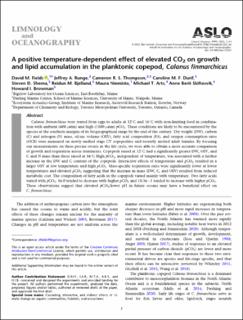| dc.contributor.author | Fields, David M. | |
| dc.contributor.author | Runge, Jeffrey A. | |
| dc.contributor.author | Thompson, Cameron | |
| dc.contributor.author | Durif, Caroline | |
| dc.contributor.author | Shema, Steven D. | |
| dc.contributor.author | Bjelland, Reidun Marie | |
| dc.contributor.author | Niemisto, Maura | |
| dc.contributor.author | Arts, Michael T. | |
| dc.contributor.author | Skiftesvik, Anne Berit | |
| dc.contributor.author | Browman, Howard | |
| dc.date.accessioned | 2023-03-08T12:04:42Z | |
| dc.date.available | 2023-03-08T12:04:42Z | |
| dc.date.created | 2022-12-14T15:05:48Z | |
| dc.date.issued | 2022 | |
| dc.identifier.citation | Limnology and Oceanography. 2022, . | en_US |
| dc.identifier.issn | 0024-3590 | |
| dc.identifier.uri | https://hdl.handle.net/11250/3057039 | |
| dc.description.abstract | Calanus finmarchicus were reared from eggs to adults at 12°C and 16°C with non-limiting food in combination with ambient (600 μatm) and high (1100 μatm) pCO2. These conditions are likely to be encountered by the species at the southern margins of its biogeographical range by the end of the century. Dry weight (DW), carbon (C) and nitrogen (N) mass, oil-sac volume (OSV), fatty acid composition (FA), and oxygen consumption rates (OCR) were measured on newly molted stage CV copepodites and recently molted adult females. By focusing our measurements on these precise events in the life cycle, we were able to obtain a more accurate comparison of growth and respiration across treatments. Copepods raised at 12°C had a significantly greater DW, OSV, and C and N mass than those raised at 16°C High pCO2, independent of temperature, was associated with a further increase in the DW and C content of the copepods. Interactive effects of temperature and pCO2 resulted in a larger OSV at low temperature and high pCO2. Mass-specific respiration rates were significantly lower at lower temperatures and elevated pCO2 suggesting that the increase in mass (DW, C, and OSV) resulted from reduced metabolic cost. The composition of fatty acids in the copepods varied mainly with temperature. Two fatty acids varied with pCO2: 16:0 tended to decrease with higher pCO2 and 18:3n−3 tended to increase with higher pCO2. These observations suggest that elevated pCO2/lower pH in future oceans may have a beneficial effect on C. finmarchicus. | en_US |
| dc.language.iso | eng | en_US |
| dc.title | A positive temperature-dependent effect of elevated CO<inf>2</inf> on growth and lipid accumulation in the planktonic copepod, Calanus finmarchicus | en_US |
| dc.title.alternative | A positive temperature-dependent effect of elevated CO<inf>2</inf> on growth and lipid accumulation in the planktonic copepod, Calanus finmarchicus | en_US |
| dc.type | Peer reviewed | en_US |
| dc.type | Journal article | en_US |
| dc.description.version | publishedVersion | en_US |
| dc.source.pagenumber | 14 | en_US |
| dc.source.journal | Limnology and Oceanography | en_US |
| dc.identifier.doi | 10.1002/lno.12261 | |
| dc.identifier.cristin | 2093272 | |
| dc.relation.project | Havforskningsinstituttet: 14591-02 | en_US |
| cristin.ispublished | true | |
| cristin.fulltext | original | |
| cristin.qualitycode | 1 | |
